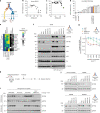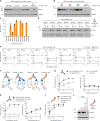Antibody targeting of E3 ubiquitin ligases for receptor degradation
- PMID: 36131013
- PMCID: PMC9534761
- DOI: 10.1038/s41586-022-05235-6
Antibody targeting of E3 ubiquitin ligases for receptor degradation
Abstract
Most current therapies that target plasma membrane receptors function by antagonizing ligand binding or enzymatic activities. However, typical mammalian proteins comprise multiple domains that execute discrete but coordinated activities. Thus, inhibition of one domain often incompletely suppresses the function of a protein. Indeed, targeted protein degradation technologies, including proteolysis-targeting chimeras1 (PROTACs), have highlighted clinically important advantages of target degradation over inhibition2. However, the generation of heterobifunctional compounds binding to two targets with high affinity is complex, particularly when oral bioavailability is required3. Here we describe the development of proteolysis-targeting antibodies (PROTABs) that tether cell-surface E3 ubiquitin ligases to transmembrane proteins, resulting in target degradation both in vitro and in vivo. Focusing on zinc- and ring finger 3 (ZNRF3), a Wnt-responsive ligase, we show that this approach can enable colorectal cancer-specific degradation. Notably, by examining a matrix of additional cell-surface E3 ubiquitin ligases and transmembrane receptors, we demonstrate that this technology is amendable for 'on-demand' degradation. Furthermore, we offer insights on the ground rules governing target degradation by engineering optimized antibody formats. In summary, this work describes a strategy for the rapid development of potent, bioavailable and tissue-selective degraders of cell-surface proteins.
© 2022. The Author(s).
Conflict of interest statement
All authors are current or former employees of Genentech.
Figures









Comment in
-
Developing antibody-based PROTACs.Nat Rev Drug Discov. 2022 Nov;21(11):795. doi: 10.1038/d41573-022-00159-2. Nat Rev Drug Discov. 2022. PMID: 36171334 No abstract available.
References
MeSH terms
Substances
LinkOut - more resources
Full Text Sources
Other Literature Sources
Molecular Biology Databases

